
Introduction
Drilling is an essential task when it comes to any DIY project or professional work. However, removing a drill bit can be challenging, especially if you are a beginner. In this article, we will guide you through the process of taking off a drill bit with ease.
Step-by-Step Guide
Step 1: Turn Off The Drill
Before you start taking off the drill bit, make sure that the drill is turned off. This is to ensure that you do not accidentally activate the drill and hurt yourself.
Step 2: Release The Chuck
The chuck is the part of the drill that holds the bit in place. To release the chuck, you need to rotate it counterclockwise. This will loosen the grip on the drill bit, allowing you to remove it easily.
Step 3: Remove The Drill Bit
Once the chuck is loosened, you can easily remove the drill bit by pulling it out of the chuck. If the drill bit is stuck, you can use pliers to grip the bit and pull it out.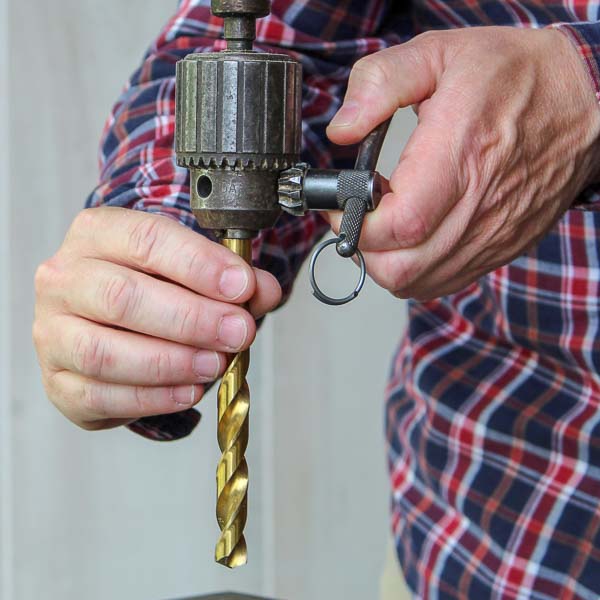
Tips For Removing Stubborn Drill Bits
Tip 1: Use A Screwdriver
If the drill bit is stuck, you can use a screwdriver to loosen it. Insert the screwdriver into the chuck and turn it counterclockwise. This will help to release the grip on the bit, making it easier to remove.
Tip 2: Apply Heat
If the drill bit is really stubborn, you can apply heat to the chuck. This will cause the metal to expand, releasing the grip on the bit. You can use a heat gun or a hairdryer for this purpose.
Tip 3: Use Lubricant
You can also use lubricant to loosen a stubborn drill bit. Apply a few drops of lubricant to the chuck and let it sit for a few minutes. This will help to loosen the grip on the bit, making it easier to remove.
Conclusion
Removing a drill bit can be a daunting task, especially if you are new to drilling. However, by following the steps outlined in this article, you can easily remove a drill bit with ease. If you encounter a stubborn drill bit, try one of the tips outlined above to make the process easier.Related video of How To Take Off Drill Bit
Quicksand is a mixture of sand, water, and air. It is a dangerous natural phenomenon that can swallow humans and animals. If you find yourself stuck in quicksand, it can be a terrifying experience, but there are ways to survive. In this article, we will discuss some tips on how to survive quicksand.
1. Don't Panic

The first and most important thing to do is not to panic. Panicking can cause you to sink faster, and it can also make it difficult for you to think clearly. Take a deep breath and stay calm.
2. Spread Your Weight

Try to spread your weight to create a larger surface area. If you keep your weight concentrated in one spot, you will sink faster. Try to move your arms and legs slowly to create a larger surface area.
3. Lay Back

If you are sinking, try to lay back. This will help to distribute your weight more evenly, and it will also help you to stay afloat. Keep your head up and try to relax.
4. Remove Any Heavy Objects

If you have any heavy objects on you, try to remove them. This will help to reduce your weight and make it easier for you to stay afloat.
5. Use Your Arms

Use your arms to paddle your way out of the quicksand. Try to move your arms slowly and smoothly to avoid splashing water and sinking faster.
6. Call for Help
If possible, call for help. Shout for assistance to draw attention to your location. If you have a cell phone, try to call for help. If you don't have a phone, try to signal for help using any available items.
7. Wiggle Your Feet

Wiggle your feet to create space for water to flow through. This will help to loosen the sand and make it easier for you to get out of the quicksand.
8. Don't Struggle
Don't struggle too much. The more you struggle, the faster you will sink. Try to move slowly and smoothly to avoid sinking.
9. Stay Upright
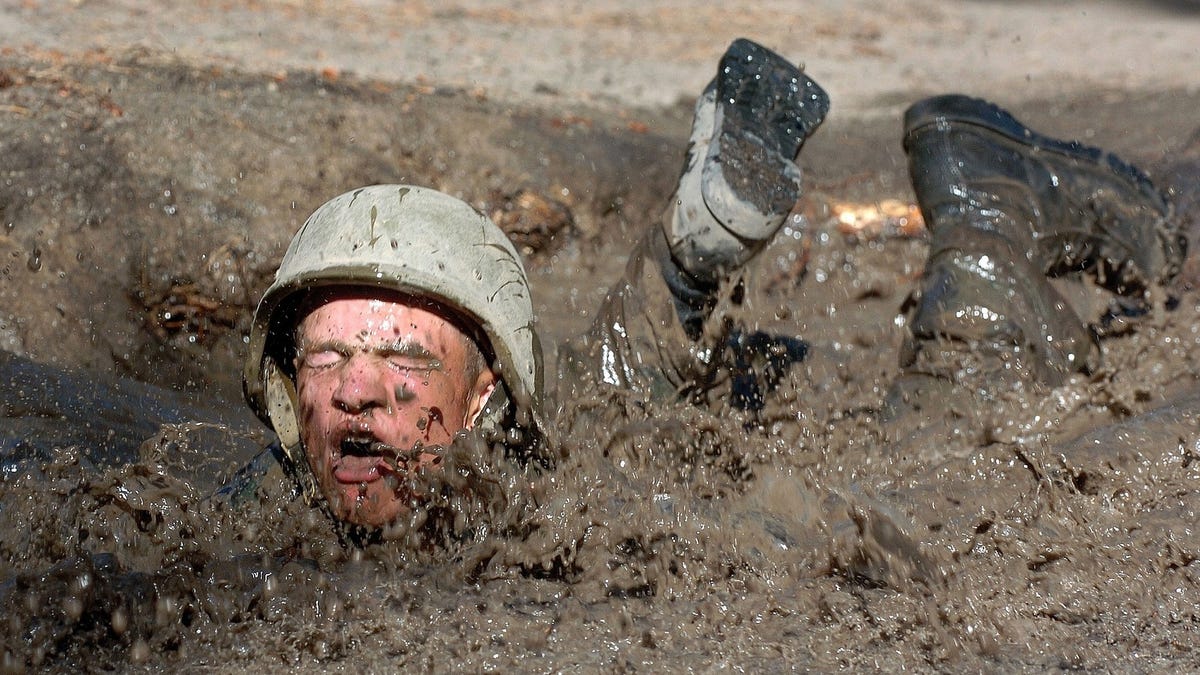
Try to stay upright. This will help you to keep your head above the water and make it easier for you to breathe. If you start to sink, try to lay back to distribute your weight more evenly.
10. Use a Stick
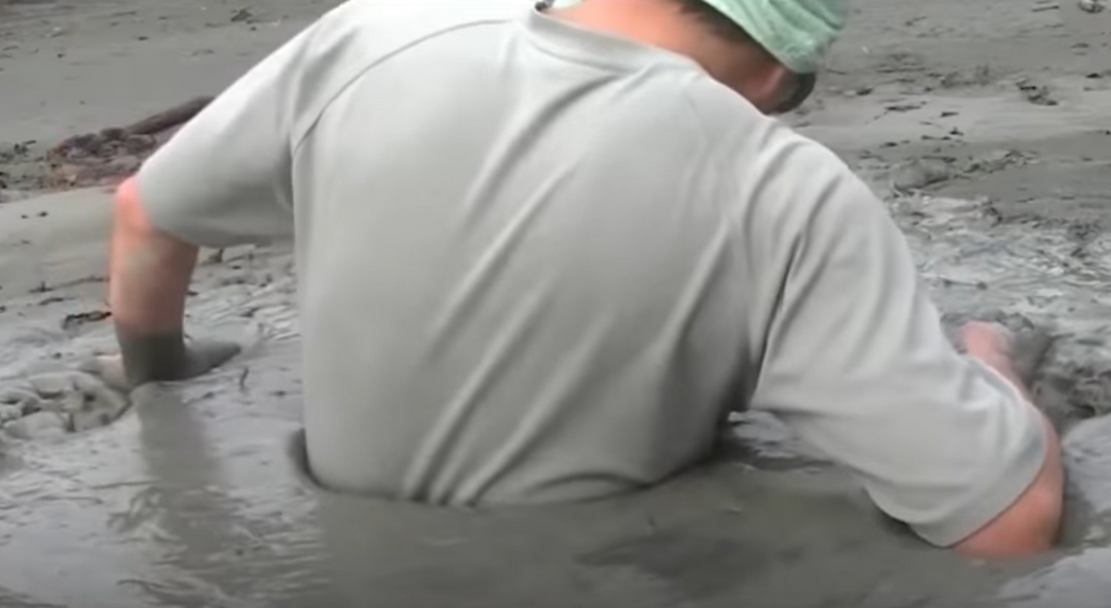
If you have a stick or any long object, use it to help you get out of the quicksand. Push the stick into the sand and use it to pull yourself out.
11. Wait for Help
If you can't get out of the quicksand, wait for help. Try to stay calm and conserve your energy. Help will arrive soon.
12. Don't Lie Down

Don't lie down on your back. This will cause you to sink faster. Try to stay upright and keep your head above the water.
13. Stay Warm
Try to stay warm. Quicksand can be cold and wet, which can cause hypothermia. If possible, cover yourself with any available clothing or items to keep yourself warm.
14. Stay Hydrated

Try to stay hydrated. Quicksand can be dehydrating, and it can also cause saltwater ingestion. If possible, try to drink any available water to stay hydrated.
15. Keep Your Feet Moving

Keep your feet moving to avoid getting stuck. If you stop moving, you will sink faster. Try to keep your feet moving to create space for water to flow through.
16. Use Your Hands
Use your hands to grab onto any available objects. If there are any branches or rocks nearby, use them to pull yourself out of the quicksand.
17. Don't Drink the Water

Don't drink the water. The water in the quicksand can be contaminated, and it can cause illness or infection. Try to avoid swallowing any water.
18. Stay Positive

Stay positive. Quicksand can be a scary experience, but it is survivable. Try to stay optimistic and believe that you can get out of the quicksand.
19. Seek Medical Attention

Seek medical attention as soon as possible. Even if you manage to get out of the quicksand, you may have injuries or illnesses that require medical attention.
20. Avoid Quicksand

The best way to survive quicksand is to avoid it. Try to stay away from areas with quicksand, and if you have to cross a quicksand area, do it with caution.
Related video of How To Survive Quicksand
Overripe bananas are often seen as a disappointment, but they can be a blessing in disguise. Instead of throwing them out, you can use them for a variety of purposes like baking, smoothies or even freezing for later use. However, before you can do any of that, you need to know how to store them properly. Here are some tips on how to store overripe bananas.
1. Keep Them In The Fridge

If you have overripe bananas and don't plan on using them right away, put them in the fridge. The cool temperature will slow down the ripening process and keep them fresh for a few more days. You can store them in the fridge for up to a week.
2. Freeze Them
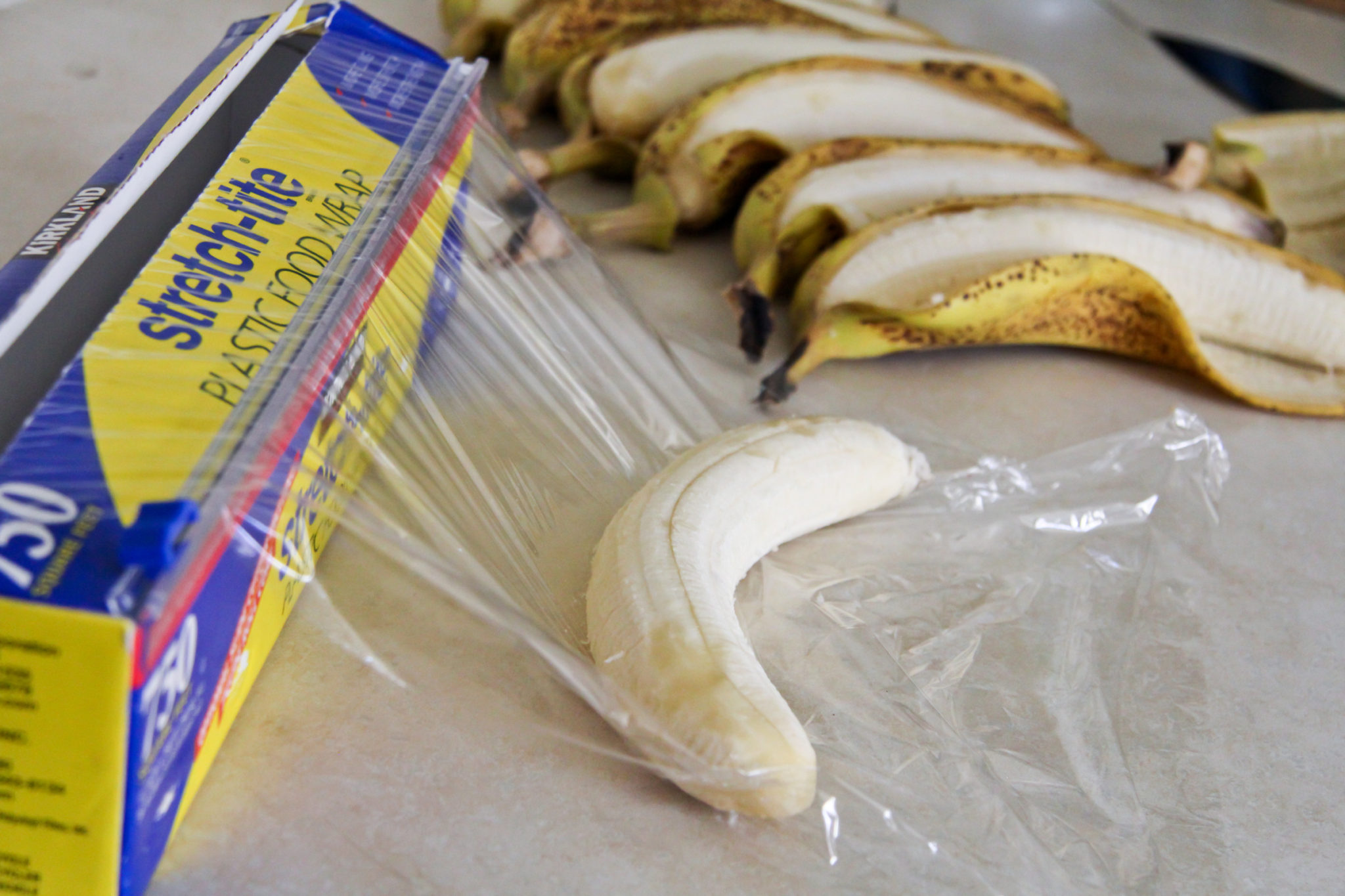
If you can't use your overripe bananas within a week, you can freeze them. Peel the bananas and place them in a zip-lock bag or an airtight container. You can store them in the freezer for up to six months. You can use frozen bananas for smoothies, baking, or even making banana ice cream.
3. Store Them In A Paper Bag

If you don't want to put your bananas in the fridge, you can store them in a paper bag. The bag will trap the ethylene gas that bananas produce, which will slow down the ripening process. This method will keep your bananas fresh for a few more days.
4. Place Them In A Fruit Bowl

If you want to display your bananas, you can place them in a fruit bowl. However, make sure to keep them away from other fruits. Bananas produce ethylene gas, which can cause other fruits to ripen faster. Keep them in a cool, dry place to prevent them from over-ripening.
5. Bake With Them
If you have overripe bananas, you can use them for baking. Overripe bananas are sweeter and softer, which makes them perfect for baking. You can use them for banana bread, muffins, pancakes, and more. The possibilities are endless.
6. Make Banana Smoothies
Overripe bananas are great for making smoothies. They add natural sweetness and creaminess to your smoothies. You can use them for strawberry banana smoothies, peanut butter banana smoothies, and more.
7. Use Them For Banana Ice Cream
If you want a healthy alternative to ice cream, you can make banana ice cream. Peel and freeze your overripe bananas. Once frozen, put them in a blender or food processor and blend until smooth. You can add cocoa powder, peanut butter, or other flavors to make it even more delicious.
8. Make Banana Chips

You can make your own banana chips using overripe bananas. Slice the bananas thinly and place them on a baking sheet. Bake them in the oven for a few hours until they are crispy. You can sprinkle them with cinnamon or sugar for added flavor.
9. Use Them For Face Masks
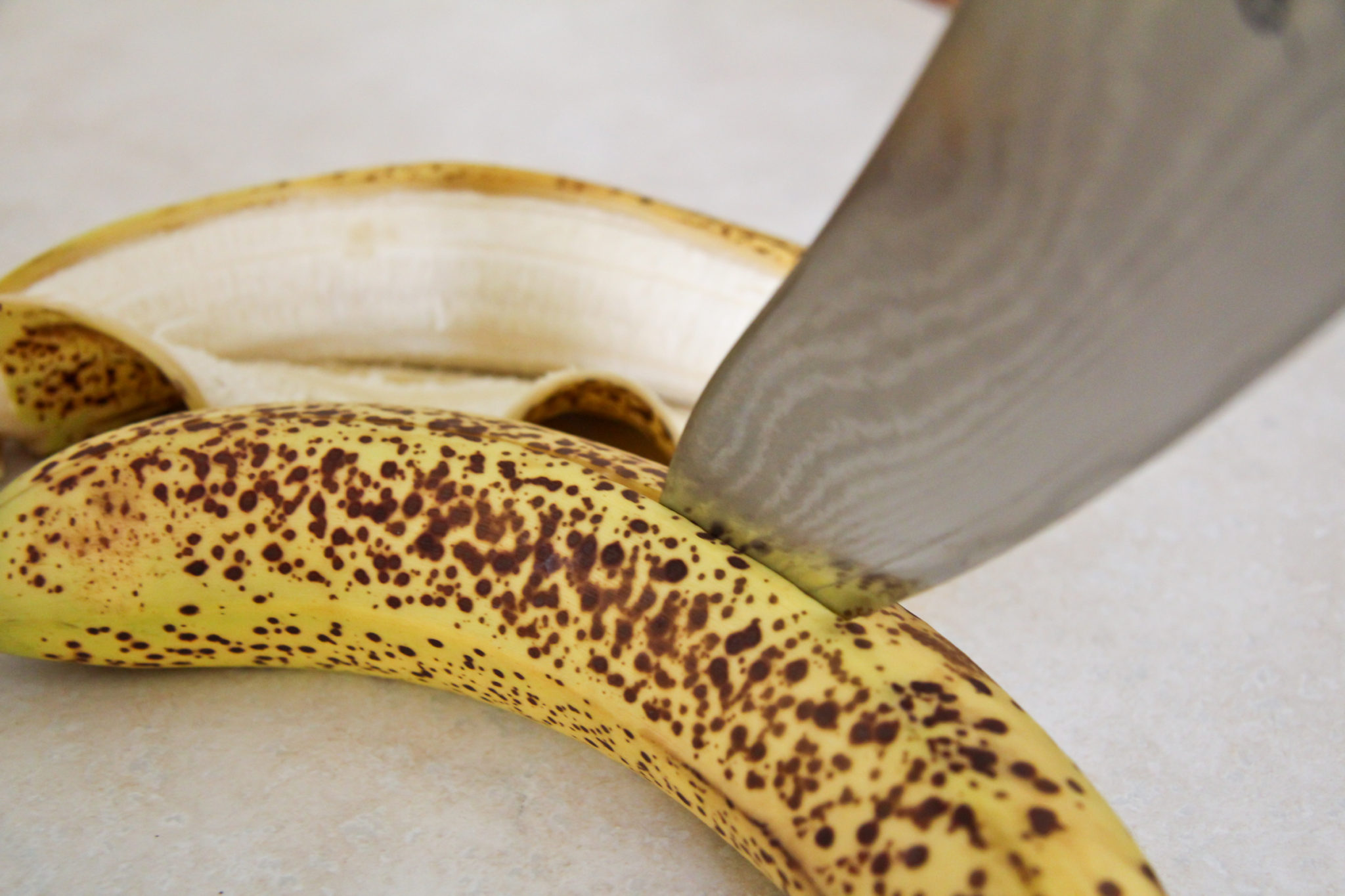
Overripe bananas are not only good for eating, but they are also good for your skin. You can use them to make a face mask. Mash a ripe banana and apply it to your face. Leave it on for 15-20 minutes and rinse it off with warm water. Your skin will feel soft and smooth.
10. Make Banana Jam

You can make banana jam using overripe bananas. Mash the bananas and add sugar and lemon juice. Cook over low heat until it thickens. You can store the jam in a jar and use it for toast, scones, and more.
Conclusion
Overripe bananas are not a problem. They are an opportunity to get creative in the kitchen. You can use them for baking, smoothies, ice cream, and more. By following these storage tips, you can make the most out of your overripe bananas.
Related video of How To Store Overripe Bananas
Stomach noises can be embarrassing and uncomfortable, especially when they happen in quiet or public places. They are also known as stomach growling or rumbling, and they occur when gas or fluid moves through the digestive system. Fortunately, there are ways to reduce or stop stomach noises. Here are some tips:
1. Eat Smaller Meals

Eating smaller meals throughout the day instead of three large ones can help reduce stomach noises. When you eat a large meal, your stomach has to work harder to digest it, and this can cause gas and fluid to move around more. Eating smaller meals can also help you maintain stable blood sugar levels and prevent overeating.
2. Chew Slowly and Thoroughly

Chewing your food slowly and thoroughly can also help reduce stomach noises. When you chew your food well, it is easier for your stomach to break it down and digest it. This can help prevent gas and fluid from building up in your digestive system.
3. Avoid Certain Foods
Some foods can cause more gas and fluid to build up in your digestive system, leading to more stomach noises. These foods include beans, cabbage, broccoli, onions, and carbonated drinks. Avoiding these foods or eating them in moderation can help reduce stomach noises.
4. Drink Plenty of Water

Drinking plenty of water can also help reduce stomach noises. When you are dehydrated, your digestive system has to work harder to break down food, and this can cause more gas and fluid to build up. Drinking water can help keep your digestive system hydrated and functioning properly.
5. Relax and Reduce Stress

Stress can also cause stomach noises. When you are stressed, your body releases hormones that can affect your digestive system. Relaxation techniques such as deep breathing, meditation, and yoga can help reduce stress and prevent stomach noises.
6. Take Probiotics

Probiotics are beneficial bacteria that live in your digestive system. They help break down food and prevent harmful bacteria from growing. Taking probiotic supplements or eating probiotic-rich foods such as yogurt and sauerkraut can help improve your digestive health and reduce stomach noises.
7. See a Doctor

If your stomach noises are persistent or accompanied by other symptoms such as pain, bloating, or diarrhea, you should see a doctor. These may be signs of an underlying digestive disorder such as irritable bowel syndrome, celiac disease, or inflammatory bowel disease.
Conclusion
Stomach noises can be uncomfortable and embarrassing, but there are ways to reduce or stop them. Eating smaller meals, chewing food slowly and thoroughly, avoiding certain foods, drinking plenty of water, relaxing and reducing stress, taking probiotics, and seeing a doctor if necessary can all help improve your digestive health and reduce stomach noises.
Related video of How To Stop Stomach Noises
Wearing glasses is a necessity for many people, but it can be frustrating when they fog up. This is especially true when the weather is cold or humid. Fortunately, there are many ways to stop foggy glasses from ruining your day. In this article, we will discuss some tips and tricks to help you keep your glasses clear and comfortable.
Why Do Glasses Fog Up?
Glasses fog up when warm, moist air from your breath meets the cool surface of your lenses. This happens more frequently when it's cold or humid outside. The moisture in the air condenses on the cooler surface of the glasses, creating a layer of water droplets that obscures your vision. The problem is exacerbated when you wear a mask, as it directs the warm air from your breath upward toward your glasses.
1. Keep Your Glasses Clean

One of the easiest and most effective ways to prevent foggy glasses is to keep them clean. Dirt, oils, and smudges on your lenses can trap moisture, making fogging more likely. Use a microfiber cloth and a cleaning solution designed for eyeglasses to clean your lenses daily. Avoid using household cleaners, as they can damage your glasses.
2. Adjust Your Mask

If you wear a mask, make sure it fits properly. A well-fitting mask should cover both your nose and mouth, with no gaps around the edges. If your mask is too loose, it will direct more warm air upward toward your glasses, making them fog up more easily. You can also try using a mask with a wire nose bridge, as it can help to direct air downward instead of upward.
3. Use Anti-Fogging Products
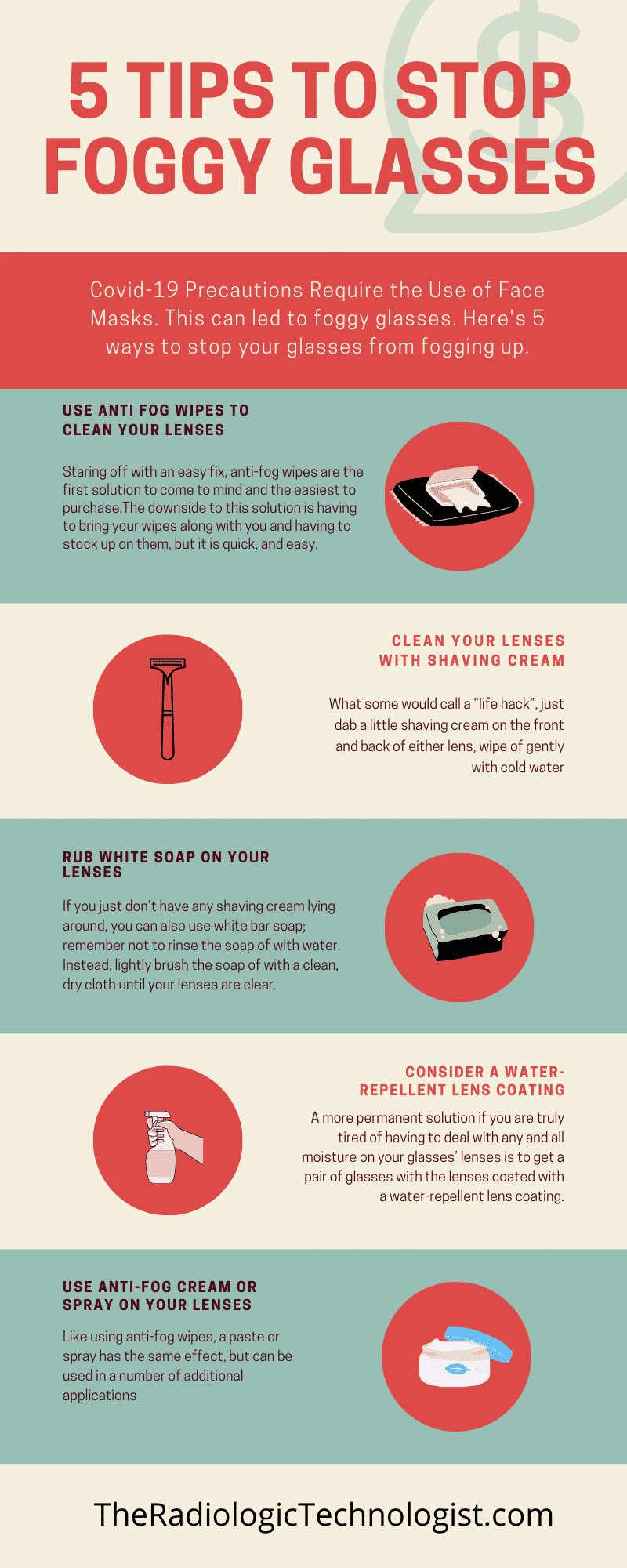
There are many products available that can help to prevent foggy glasses. Anti-fogging sprays, wipes, and creams can all be effective. These products work by creating a thin film on your lenses that prevents moisture from condensing on them. Some products are designed specifically for glasses, while others are multi-purpose and can be used on other surfaces as well.
4. Adjust Your Glasses

The way your glasses sit on your face can affect how much they fog up. If your glasses sit too close to your face, they will trap more warm air, making fogging more likely. Adjust the fit of your glasses by gently bending the temples outward or inward. You can also try pushing your glasses higher up on your nose, as this will allow more air to circulate around them.
5. Keep Your Face and Glasses Warm

Keeping your face and glasses warm can also help to prevent foggy glasses. Wear a scarf or a hat that covers your ears and forehead, as this will help to trap warm air around your face. You can also try running warm water over your glasses before putting them on, as this will help to warm them up and prevent condensation.
6. Choose the Right Frames

The type of frames you choose can also affect how much your glasses fog up. Frames that fit close to your face, such as wraparound or sport frames, are more likely to trap warm air and cause fogging. Frames with adjustable nose pads can help to create a better fit and allow more air to circulate around your glasses.
7. Try Contact Lenses

If you're tired of dealing with foggy glasses, you might consider trying contact lenses. Contacts sit directly on your eyes, so they won't fog up like glasses do. However, contacts require more maintenance and can be more expensive than glasses. Talk to your eye doctor to see if contacts are a good option for you.
Conclusion
Foggy glasses can be a nuisance, but they don't have to ruin your day. By using these tips and tricks, you can keep your glasses clear and comfortable, no matter what the weather is like outside. Choose the methods that work best for you, and enjoy clear vision all day long.